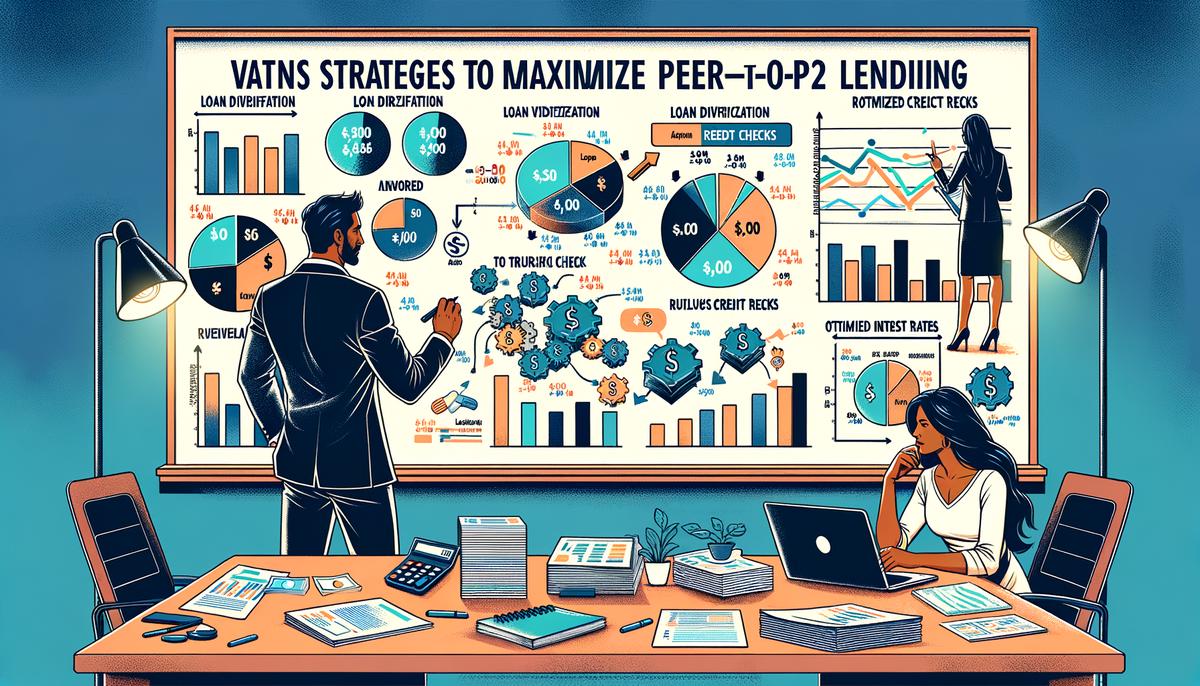Understanding Peer-to-Peer Lending
Peer-to-Peer Lending Unlocked: Your Guide to Earning and Borrowing
So, you’re curious about peer-to-peer lending, huh? Well, you’re in the right spot! Today, we’re diving deep into the world of peer-to-peer lending, explaining all the nitty-gritty details but in a way that’s super easy to grasp. Whether you’re looking to invest some cash or borrow a bit for your next big thing, understanding peer-to-peer lending is a game-changer.
What Exactly is Peer-to-Peer Lending?
Think of peer-to-peer (P2P) lending as the cool, modern cousin of traditional banking. Instead of going to a bank to borrow money, you get it directly from another person. On the flip side, if you’re looking to invest, you can lend your money directly to someone who needs it. This whole exchange happens on P2P platforms – think of them as the matchmakers of the finance world.
How Does it Work?
The process is pretty straightforward. For borrowers, it starts with an application, which the P2P platform reviews. They check out your credit score, financial history, and sometimes even why you need the loan. This info helps them decide if you’re a good candidate and what interest rate they should offer you.
For investors, you get to pick where your money goes. You can select specific borrowers, choose a risk level you’re comfy with, or even spread your money out across different loans to reduce risk. It’s all about finding the balance that works for you.
What’s in it for Borrowers?
If you’re looking to borrow, P2P lending offers some sweet perks. Often, you can snag lower interest rates than traditional banks offer. Plus, the application process is usually streamlined and digital, meaning you get an answer fast and without all the paperwork. And, since each platform has its own criteria, even folks with less-than-perfect credit scores might find funding here.
And Investors? What’s the Deal for Them?
For those looking to invest, P2P lending could be a gold mine. The returns can be significantly higher compared to other safe investments like savings accounts or even some bonds. And because you’re directly lending to individuals, you have a clearer idea of where your money’s going and the impact it’s making. Feeling like a mini-bank has its perks!
Risks? Yeah, There Are Some…
Like everything in life, there’s no reward without risk. For borrowers, the biggest risk is getting a high-interest rate, especially if your credit score isn’t stellar. For investors, the main worry is borrowers defaulting on their loans. While platforms do their best to mitigate these risks, they’re still part of the game.
Platforms to Check Out
Ready to dive in? There are tons of platforms to explore. Prosper and LendingClub are big names in the U.S., offering a variety of loans and investment opportunities. Just remember to do your homework, read the fine print, and choose a platform that aligns with your needs and risk tolerance.
Peer-to-peer lending is reshaping how we think about loans and investments. Whether you need a loan for a big project or you’re looking to grow your nest egg, P2P lending has something to offer. So, why not explore this modern finance avenue and see where it can take you?

Starting as a P2P Investor
How Can You Start Investing in Peer-to-Peer Lending?
So, you’re keen on jumping into the world of peer-to-peer (P2P) lending as an investor — that’s awesome! This exciting opportunity allows you to lend money directly to others without the traditional banking system stepping in. Think of it like being a mini-bank, where you get to call the shots on where your money goes. But how exactly do you dive into this game and start seeing returns? Let’s break it down into simple, actionable steps.
Getting Started: Research and Choose a Platform
First thing’s first, you need to pick a platform. Remember, not all P2P lending sites are created equal, and each has its unique features, risks, and rewards. Do your homework! Look for platforms with a strong reputation, transparent fees, and solid track records. Some well-known names include Prosper and LendingClub, but there are plenty out there. Dig into user reviews, and possibly even reach out to current investors on the platform to get the real scoop.
Setting Up Your Account
Once you’ve chosen your champion (a.k.a. platform), it’s time to set up shop. Opening an account typically involves some light paperwork and identity verification to meet regulatory standards. This process isn’t much different from setting up an online banking account. Plus, many platforms allow you to start with relatively small amounts of cash, so you don’t need a treasure chest to get going.
Understanding Risk and Return
Before you start tossing your dollars into the ring, let’s talk risk and return. P2P lending can offer higher returns than traditional savings accounts or CDs, but with that comes higher risk. Not everyone you lend to will pay back their loan. Mitigate your risks by diversifying your investments across multiple loans rather than putting all your eggs in one basket. Also, take advantage of any risk assessment tools the platform offers to gauge the risk profile of potential borrowers.
Funding Loans
Now for the fun part — funding loans. Platforms typically present a variety of loans for investors to choose from, each with details about the borrower’s credit score, loan purpose, and proposed interest rate. Some platforms allow you to hand-pick individual loans, while others will automatically spread your investment across a diverse mix based on your risk preferences. Either way, you’re in control. Start small if you’re testing the waters and gradually increase your investment as you grow more comfortable.
Monitoring Your Investment
After your funds are dispersed, it’s tempting to just kick back and wait for the returns to roll in. But smart investors keep a close eye on their portfolios. Monitoring your loans lets you track repayments and assess the performance. If you notice patterns of delays or defaults, you might need to adjust your strategy.
Reinvesting Returns
One of the keys to maximizing your earnings in P2P lending is to reinvest your returns. As you start to receive repayments, you can either withdraw your funds or reinvest them into new loans. Reinvesting not only compounds your interest but also spreads your risk across more loans over time.
Stay Informed
Lastly, the world of P2P lending, like any investment opportunity, evolves. Stay informed about changes in regulations, platform updates, and trends in borrower behavior. The more knowledgeable you are, the better your chances of making savvy investment decisions.
And there you have it — your roadmap to starting your journey in peer-to-peer lending. With some research, smart decision-making, and a dash of caution, you could be well on your way to earning extra cash through P2P investing. Just remember, all investments carry risks, so never invest money you can’t afford to lose. Now, go forth and lend!

Risks and How to Mitigate Them
Navigating the Pitfalls of P2P Lending: A Guide to Smarter Investing
Peer-to-Peer (P2P) lending is the cool, modern way to either lend your money for interest or get a loan without the traditional bank hassle. As trendy as it sounds, it comes with its own set of risks, just like any investment opportunity. But don’t sweat it too much. With a bit of savvy maneuvering, you can mitigate these risks and potentially make P2P lending a worthwhile addition to your investment portfolio. Let’s dive into understanding these risks better and discover how to play it smart.
1. Credit Risk:
The scary possibility that the borrower might not pay you back. It’s the dark cloud hanging over the heads of most P2P lenders. However, you can shine a light by diversifying your loans. Don’t put all your eggs in one basket, or better said, don’t lend all your money to one borrower, no matter how reliable they seem. Spread your investment across multiple loans. This way, if one borrower defaults, you’re not losing all your hard-earned cash.
2. Platform Dependability:
Imagine investing in a platform that ends up being the Titanic, sinking your investment hopes. Yikes! Always do your homework before choosing a platform. Look for platforms with a strong track record, transparent operations, and good reviews. Digging into their history might sound like a chore now, but it’s better than facing unexpected icebergs down the line.
3. Liquidity Risk:
What if you suddenly need your money back but find out it’s all tied up in loans? Unlike a savings account where you can withdraw cash on a whim, P2P lending doesn’t always offer quick cash-outs. To combat this, consider platforms that offer a secondary market, where you can sell your loan to another investor, or opt for short-term loans that match your cash-flow needs. Planning is your best friend here.
4. Market Risk:
The economy is like a wild roller coaster – thrilling highs and terrifying lows. A downturn can mean more borrowers defaulting. Staying informed about the general economic climate and adjusting your lending strategy accordingly can help. Maybe during tough times, lean towards more secured loans or loans with higher interest rates to counterbalance the increased risk.
5. Interest Rate Risks:
Interest rates can go up or down, affecting your returns. If you lock in a loan at a lower rate and then rates shoot up, you’re stuck with the lower returns. Keeping a mix of short-term and long-term loans can help you manage this risk better. When rates are low, go short-term so you can reinvest at higher rates later.
6. Cybersecurity Risks:
In today’s digital age, cyber threats are real. When choosing a P2P platform, ensure they have robust security measures in place to protect your investment. Look for platforms that offer insurance or protection funds for an added layer of security.
Mitigating Risks with Education: Knowledge is power. The more you know about P2P lending, the better equipped you’ll be to mitigate risks. Many platforms offer educational resources for investors. Take advantage of these. Stay hungry for knowledge, and keep up with trends, changes in regulations, and shifts in borrower behavior.
By taking calculated steps and being well-informed, you can steer clear of the major pitfalls associated with P2P lending. Remember, every investment has its risks, but with the right strategies, you can work towards securing a more favorable outcome. Happy lending!

Maximizing Returns in P2P Lending
Diving further into the world of P2P (peer-to-peer) lending, let’s uncover additional strategies and insights to maximize your returns. Given the groundwork laid by understanding the basics and recognizing the inherent risks, it’s time to fine-tune our approach towards achieving a more profitable P2P lending journey.
Diversify Your Loans Portfolio
Much like traditional investing, diversification is key in P2P lending. Instead of putting all your eggs in one basket by funding a single borrower, spread your investment across multiple loans. This strategy reduces the impact of a default on your overall returns. Think of it as not just backing one runner in a race but having a stake in multiple runners. If one stumbles, your overall race outcome still has the potential to be positive.
Evaluate Borrower Profiles
While platforms often assess and rate borrowers, taking a personal deep dive into borrower profiles can provide additional assurance. Look beyond the surface of credit ratings. Consider factors such as employment stability, debt-to-income ratio, and even the purpose of the loan. Loans towards debt consolidation or personal improvement like education often carry a lower risk compared to high-risk ventures.
Choose Your Interest Rates Wisely
P2P platforms typically offer a range of interest rates, corresponding to the level of risk associated with lending to various borrowers. Higher interest rates are tempting due to their promise of greater returns. However, they also come with a higher risk of default. Balancing your portfolio with a mix of high, medium, and low interest rate loans can optimize your returns while mitigating risk.
Engage in Active Loan Management
Active management of your investments can significantly enhance your P2P lending outcomes. This involves periodically reviewing your loan portfolio, tracking borrower repayments, and being on the lookout for any early signs of default. If a loan starts to go south, some platforms allow you to sell your stake to another investor, albeit possibly at a loss. However, cutting losses early can free up capital for more promising opportunities.
Leverage Auto-Invest Features
Many P2P lending platforms offer an auto-invest feature, which automatically places your funds into new loans based on your selected criteria. This tool can save you time and effort in selecting individual loans. Plus, it keeps your capital working for you continuously, avoiding the pitfall of idle funds. Ensure to regularly review and adjust the settings to align with your risk tolerance and investment goals.
Keep an Eye on Fees
Understanding the fee structure of your chosen P2P lending platform is crucial. While some fees are upfront and evident, others might be less obvious. High fees can eat into your returns, making what seems like a profitable venture less appealing. Compare platforms not just on the returns they project but also on the cost of investing with them.
Stay Informed
The P2P lending space is dynamic, with regulations, technologies, and market trends constantly evolving. Staying informed about industry developments can help you anticipate changes that might affect your investments. Engaging with community forums and financial news related to P2P lending will enable you to make more educated decisions and adapt your strategies accordingly.
Incorporating these strategies into your P2P lending activities can significantly impact your success as an investor. While P2P lending offers the enticing prospect of attractive returns, it’s essential to approach it with diligence, a strategic mindset, and a clear understanding of the risks involved. By actively managing your investments and staying informed, you can navigate the P2P lending world more confidently and profitably.

The Future of Peer-to-Peer Lending
As we look toward the horizon, the future of peer-to-peer (P2P) lending appears vibrant, teeming with potential yet littered with challenges awaiting creative solutions. The evolution of this booming industry can be likened to a roller coaster, thrilling and unpredictable. What then, does destiny hold for P2P lending? Let’s dive deep!
Technological Advancement: The Digital Transformation
First off, technology is set to play an even bigger role. We’re talking artificial intelligence and machine learning algorithms that could revolutionize how borrowers are matched with investors, making the process more efficient and possibly reducing default rates by predicting borrower behavior more accurately. Imagine a platform that intuitively understands your financial goals and aligns them with the perfect investment opportunities, all in real-time. The future seems poised to make these scenarios a reality.
Blockchain and Decentralization: A New Frontier?
Blockchain technology has been buzzword-heavy, but its potential application in P2P lending is genuinely exciting. By decentralizing operations, blockchain can offer greater transparency and security, reducing the risk of fraud and eliminating the need for intermediaries. This could result in lower fees for participants and potentially open the door to global markets, making it easier for investors and borrowers from different parts of the world to connect.
Regulatory Landscapes: Navigating Through Changes
With the growth of P2P lending, regulatory scrutiny is inevitable. However, this isn’t necessarily a bad thing. Clear, fair regulations can help stabilize the industry, protect participants, and foster trust. The future may see more standardized regulatory frameworks across borders, allowing for international expansions and partnerships. Staying informed and compliant will be key for platforms wishing to lead the pack.
A Shift Towards Niche Lending
As the market matures, we might witness a proliferation of platforms catering to specific niches. From green investments and social lending to sectors like healthcare and education, specialized platforms could offer borrowers and investors more tailored opportunities and possibly better rates due to their focused approach. This segmentation could enrich the ecosystem, providing more avenues for investors to align their portfolios with their passions or beliefs.
The Emergence of Hybrid Models
The collaboration between traditional financial institutions and P2P platforms might become more commonplace. Banks could leverage the agility and innovative technology of P2P platforms while offering their robust infrastructure and regulatory expertise. This symbiotic relationship could expand the market, offering consumers the best of both worlds and potentially creating a more resilient financial landscape.
Challenges and Adaptations
It’s not all smooth sailing ahead, though. The P2P lending industry will need to continually adapt to overcome hurdles such as economic fluctuations, evolving cyber threats, and the need for enhanced borrower assessments. Platforms that prioritize adaptability, customer service, and robust risk management practices are likely to thrive.
Conclusion: A Flourishing Ecosystem with a Note of Caution
The future of P2P lending is undoubtedly exciting, filled with opportunities for innovation, growth, and financial democratization. Yet, it’s a future that demands vigilance, creativity, and a commitment to ethical practices. As technological advancements pave the way for more sophisticated lending platforms, participants must navigate the evolving landscape with a keen eye on potential risks and regulatory changes.
For investors and borrowers alike, the key will be to stay informed, diversify wisely, and choose platforms that align with their financial goals and values. As we continue on this journey, the promise of a more inclusive, efficient, and transparent financial system beckons.





